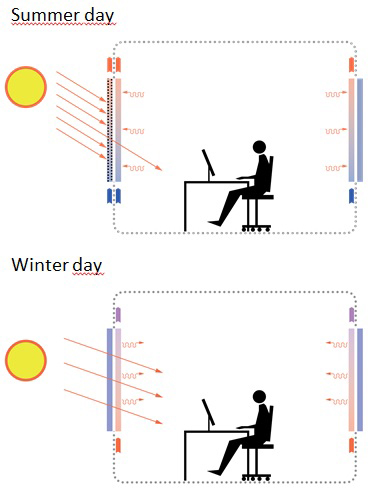 The heavy use of energy from non-renewable resources is one of the biggest problems of our time. Efficient use of energy is becoming more relevant than ever, and it must be implemented in all sectors of human activity.
The heavy use of energy from non-renewable resources is one of the biggest problems of our time. Efficient use of energy is becoming more relevant than ever, and it must be implemented in all sectors of human activity.
The highest contributor to the generation of Green House Gases is the creation and operation of built environment. The average value is estimated in most developed countries at close to 33%, knowing that around 40% of the total energy use corresponds to buildings, while their fossil fuel heating represents a major share. Consequently, the built environment in Europe needs to be designed, built, operated and refurbished with much higher energy efficiency.
A new and innovative concept of solar thermal façades has been developed in FLUIDGLASS project for use at building level, increasing flexibility and energy efficiency. Liquid is circulated in spaces of transparent window panes, transforming passive façades into active collectors that are capable to react on changing interior and exterior environmental conditions. This opens new routes of advanced thermal building management embedded in energy networks at district level to significantly improve the thermal performance of the building envelope and the comfort for the user.
The collector panel is a combination of fluid and glass layers and a thermal barrier. In this way, an optimized configuration of the layers can be assembled for different applications and different sections of the building envelope. The basic element of FLUIDGLASS remains the same, but the combination of the different layers allows wide applicability and simple production process. For example: Shading can be provided by tinted glass or fl uid (fixed or adjustable). This modular approach has the advantage to offer customized panels depending on the user's need.
In the most advanced approach, two fluid filled layers are implemented in the glass façade. These two layers regulating all energy flow within the façade. The fluid layer to the interior space keeps the inside surface temperature just below or above room temperature for heating and cooling, while the liquid layer to the exterior controls the energy transmission by absorption of the solar irradiation.
FLUIDGLASS proposes a disruptive innovation in façade systems - transparent solar thermal façade system combining solar thermal collector, insulation glazing, shading device and heating/cooling panel in one element. This unique system doesn't offer just a better performance characteristics than competing products, moreover it is the only solution for a large number of glazed buildings where opaque collectors cannot be installed due to aesthetics, usage or construction type reasons. Since FLUIDGLASS allows all these additional buildings to become potentially net-zero in heating and cooling, the macro economic impact is by far higher than the impact of competing approaches, which only offer slight efficiency improvements for existing solutions.
The project FLUIDGLASS receives funding from the European Union Seventh Framework Programme (FP7/2007-2013) under Grant agreement n° 608509